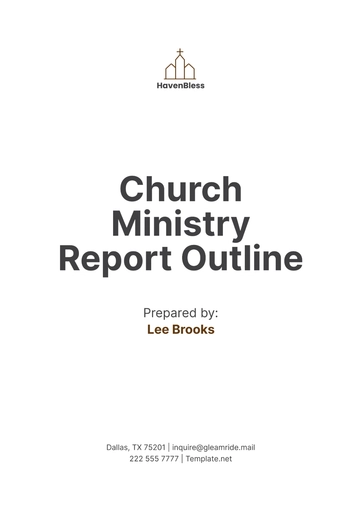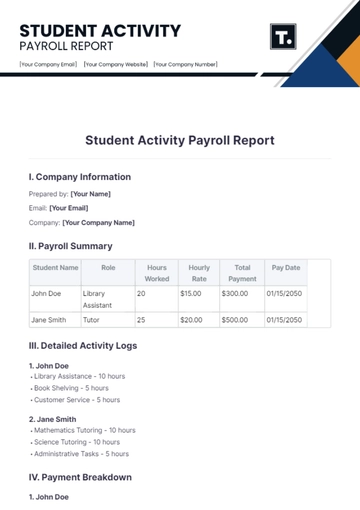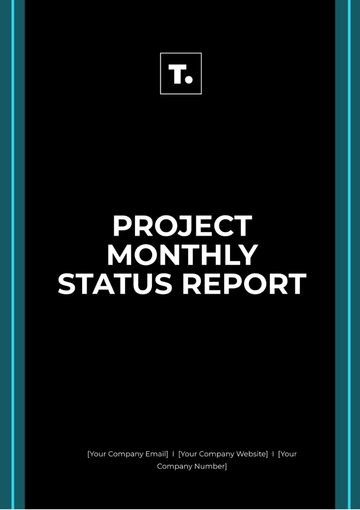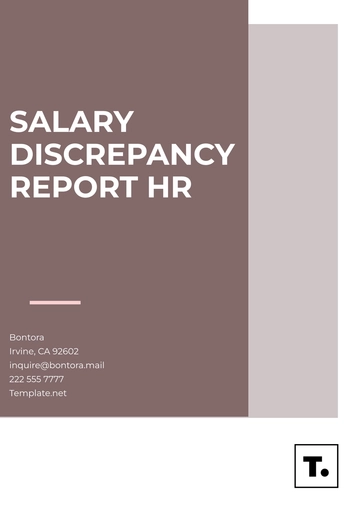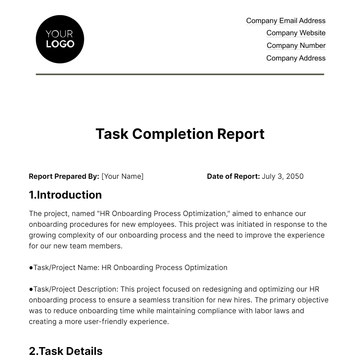Free Attendance Report

Prepared by: [YOUR NAME]
Company: [YOUR COMPANY NAME]
Date: [DATE]
I. Introduction
The [EDUCATIONAL INSTITUTION] Student Attendance Monitoring Report is designed to provide a comprehensive overview of student attendance data for analysis and intervention purposes. This report aims to assist educational professionals in tracking attendance trends, identifying areas of concern, and implementing strategies to support student success. By systematically documenting attendance information, [YOUR INSTITUTION] can better understand student engagement levels and take proactive measures to address any attendance-related issues.
II. Attendance Summary
The Attendance Summary section provides an overview of attendance data for the specified reporting period. It includes key metrics such as total number of students, total number of days in the reporting period, and overall attendance rate. This section also highlights any significant trends or patterns observed in student attendance, such as variations by grade level, time of day, or specific classes. By analyzing this summary, educational professionals can gain insights into overall attendance patterns and identify areas for further investigation or intervention.
Total Number of Students: [INSERT TOTAL NUMBER OF STUDENTS ENROLLED]
Total Number of Days in Reporting Period: [INSERT TOTAL NUMBER OF DAYS IN THE REPORTING PERIOD]
Overall Attendance Rate: [INSERT OVERALL ATTENDANCE RATE PERCENTAGE]
III. Detailed Attendance Data
The Detailed Attendance Data section provides a more granular view of student attendance, broken down by individual students and days. This section typically includes a table format with columns for student names, dates, and attendance status (e.g., present, absent, tardy). Educational professionals can use this detailed data to track individual student attendance patterns, identify students who may be at risk of falling behind academically, and implement targeted interventions as needed. Additionally, this section may include notes or comments to provide context for any unusual attendance occurrences or trends observed during the reporting period.
STUDENT NAME | DATE | ATTENDANCE STATUS |
|---|---|---|
[INSERT STUDENT NAME] | [INSERT DATE] | [INSERT ATTENDANCE STATUS] |
[INSERT STUDENT NAME] | [INSERT DATE] | [INSERT ATTENDANCE STATUS] |
[INSERT STUDENT NAME] | [INSERT DATE] | [INSERT ATTENDANCE STATUS] |
IV. Trends and Analysis
The Trends and Analysis section offers deeper insights into attendance data by identifying trends, patterns, and potential contributing factors. Educational professionals can use this section to analyze attendance data over time, compare attendance rates across different student demographics or class types, and identify any correlations between attendance and academic performance. By understanding the underlying factors influencing student attendance, educational institutions can develop targeted interventions and support strategies to improve overall attendance rates and student outcomes.
Attendance Trends: Identify any recurring patterns or trends observed in student attendance data.
Factors Influencing Attendance: Explore potential factors influencing student attendance, such as transportation issues, health concerns, or academic engagement.
Impact on Student Success: Assess the relationship between attendance rates and academic performance, graduation rates, and overall student success.
V. Findings
The Findings section presents the key observations and insights derived from the analysis of attendance data. It highlights significant trends, patterns, and factors influencing student attendance, as well as any notable correlations with academic performance or other outcome measures. This section provides educational professionals with a deeper understanding of the factors impacting student attendance and informs the development of targeted interventions and support strategies.
Attendance Patterns: Identify recurring patterns or trends in student attendance, such as fluctuations by day of the week, time of day, or semester.
Factors Impacting Attendance: Explore the various factors influencing student attendance, including personal, family, and environmental factors, as well as school-related issues.
Correlation with Academic Performance: Analyze the relationship between attendance rates and academic performance indicators, such as grades, standardized test scores, and graduation rates.
VI. Recommendations and Interventions
The Recommendations and Interventions section provides actionable recommendations based on the analysis of attendance data. Educational professionals can use this section to propose targeted interventions and support strategies aimed at improving student attendance and engagement. Recommendations may include implementing attendance incentives, providing additional support services for at-risk students, or collaborating with families and community stakeholders to address underlying barriers to attendance.
Attendance Incentive Programs: Develop and implement attendance incentive programs to motivate students to attend classes regularly.
Student Support Services: Provide access to counseling, tutoring, or mentoring programs to support students who may be experiencing attendance-related challenges.
Family and Community Engagement: Foster partnerships with families, caregivers, and community organizations to address external factors impacting student attendance, such as transportation issues or family responsibilities.
VII. Conclusion
The Conclusion section summarizes the key findings and recommendations outlined in the report. It underscores the importance of ongoing monitoring and intervention efforts to support student attendance and academic success. By proactively addressing attendance-related issues, educational institutions can create a supportive learning environment that maximizes opportunities for all students to thrive.
- 100% Customizable, free editor
- Access 1 Million+ Templates, photo’s & graphics
- Download or share as a template
- Click and replace photos, graphics, text, backgrounds
- Resize, crop, AI write & more
- Access advanced editor
Discover unparalleled convenience with our Attendance Report Template from Template.net. This editable and customizable template streamlines your tracking process effortlessly. Crafted to perfection, it's easily editable in our Ai Editor Tool, ensuring seamless customization. Elevate your attendance management with this indispensable tool.
You may also like
- Sales Report
- Daily Report
- Project Report
- Business Report
- Weekly Report
- Incident Report
- Annual Report
- Report Layout
- Report Design
- Progress Report
- Marketing Report
- Company Report
- Monthly Report
- Audit Report
- Status Report
- School Report
- Reports Hr
- Management Report
- Project Status Report
- Handover Report
- Health And Safety Report
- Restaurant Report
- Construction Report
- Research Report
- Evaluation Report
- Investigation Report
- Employee Report
- Advertising Report
- Weekly Status Report
- Project Management Report
- Finance Report
- Service Report
- Technical Report
- Meeting Report
- Quarterly Report
- Inspection Report
- Medical Report
- Test Report
- Summary Report
- Inventory Report
- Valuation Report
- Operations Report
- Payroll Report
- Training Report
- Job Report
- Case Report
- Performance Report
- Board Report
- Internal Audit Report
- Student Report
- Monthly Management Report
- Small Business Report
- Accident Report
- Call Center Report
- Activity Report
- IT and Software Report
- Internship Report
- Visit Report
- Product Report
- Book Report
- Property Report
- Recruitment Report
- University Report
- Event Report
- SEO Report
- Conference Report
- Narrative Report
- Nursing Home Report
- Preschool Report
- Call Report
- Customer Report
- Employee Incident Report
- Accomplishment Report
- Social Media Report
- Work From Home Report
- Security Report
- Damage Report
- Quality Report
- Internal Report
- Nurse Report
- Real Estate Report
- Hotel Report
- Equipment Report
- Credit Report
- Field Report
- Non Profit Report
- Maintenance Report
- News Report
- Survey Report
- Executive Report
- Law Firm Report
- Advertising Agency Report
- Interior Design Report
- Travel Agency Report
- Stock Report
- Salon Report
- Bug Report
- Workplace Report
- Action Report
- Investor Report
- Cleaning Services Report
- Consulting Report
- Freelancer Report
- Site Visit Report
- Trip Report
- Classroom Observation Report
- Vehicle Report
- Final Report
- Software Report



